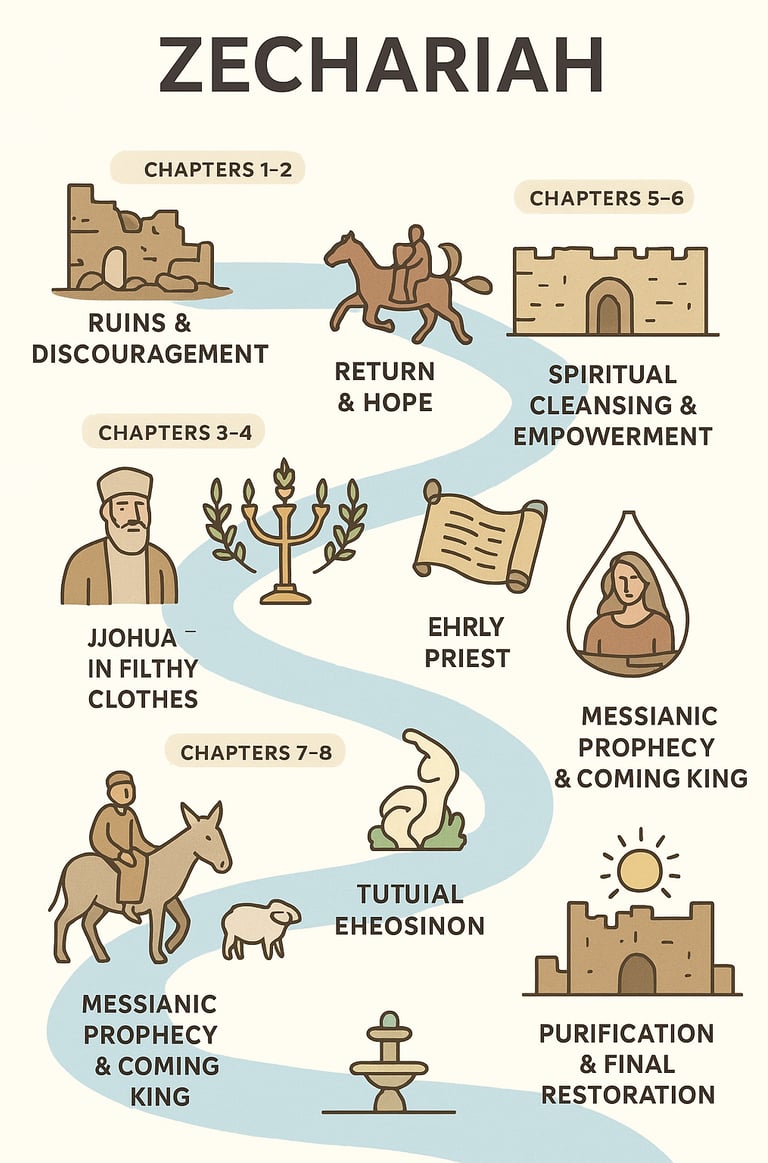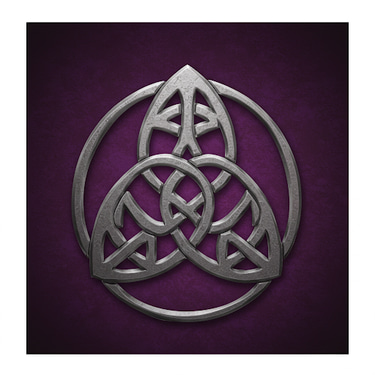Zechariah
Deborah Colleen Rose
8/19/20255 min read


When the people of Judah returned from exile, they faced not only broken walls and a half-built temple but also broken spirits. Into that discouragement, God sent the prophet Zechariah with a message that was both confronting and comforting: “Return to Me, and I will return to you.” Zechariah’s visions move like a river—from ruin to cleansing, from judgment to renewal, from despair to Messianic hope. His words remind us that God’s work is never just about rebuilding stone and timber—it is about restoring hearts, renewing leaders, and preparing His people for the coming King.Zechariah 1: A Call to Return
Context: The people have returned from exile but are discouraged; the temple is barely started.
Message: “Return to me, and I will return to you.” God wants a spiritual revival before any physical rebuilding.
Vision: Horses patrolling the earth (1:8–17) — God is aware of the whole world’s unrest and promises His justice.
Theme: God sees beyond the ruins; He will protect and restore Jerusalem.
Zechariah 2: God’s Protection and Expansion
Vision: A man measuring Jerusalem (2:1–5).
Meaning: Jerusalem is small now, but God will expand it. Restoration is more than reconstruction—it’s about blessing, security, and presence.
Promise: “I am a wall of fire around her.” God’s protection isn’t physical alone—it’s spiritual and enduring.
Zechariah 3: The High Priest Cleansed
Vision: Joshua the high priest standing before God in filthy clothes, which are replaced with clean garments.
Meaning: God forgives and removes guilt. Spiritual restoration comes first; leadership must be righteous.
Theme: Even the leaders’ sin can be washed away—symbolizing hope for the nation.
Zechariah 4: God’s Spirit Empowers the Work
Vision: Lampstand and olive trees.
Meaning: Human effort alone won’t rebuild the temple; God’s Spirit must drive the work.
Key verse: “Not by might nor by power, but by my Spirit.”
Practical takeaway: Small beginnings matter; God multiplies efforts that are Spirit-driven.
Zechariah 5: Judgment and Removal of Sin
Vision: A flying scroll (curses the thief and liar) and a woman in a basket (wickedness being carried away).
Meaning: God will remove corruption and injustice from the land. Restoration isn’t just building walls; it’s cleansing hearts.
Zechariah 6: Crowning the Future King
Vision: Four chariots with horses of different colors, going to the ends of the earth.
Message: God is in control of history; judgment and justice will be executed.
Prophetic act: Joshua, the high priest, is crowned—foreshadowing a coming “Branch” (Messiah) who unites priesthood and kingship.
Zechariah 7: True Fasting is Justice
Context: People ask why past fasts didn’t bring blessing.
Message: God doesn’t care about ritual alone; He cares about justice, mercy, and compassion.
Theme: Religion without ethical action is empty.
Zechariah 8: Promises of Renewal
Message: God promises:
Return of God’s presence.
Peace in the city.
Prosperity for the faithful.
Practical note: The seemingly weak and small community will flourish if they trust and act rightly.
Zechariah 9: Coming King and Judgment
Prophecy: A lowly king rides a donkey (fulfilled in Jesus).
Message: God will bring justice on enemies and salvation for His people.
Theme: Messianic hope—humility and peace, not military might, will prevail.
Zechariah 10: Strengthened Leaders
Message: God raises leaders to guide the people, equipping them with courage and unity.
Practical point: Leadership comes from God, not human schemes.
Zechariah 11: Shepherds and Betrayal
Vision: God as shepherd, then rejected by the people.
Meaning: The nation’s leaders fail; God’s true shepherd will suffer.
Foreshadowing: Jesus as the rejected shepherd; betrayal for “thirty pieces of silver.”
Zechariah 12: God’s People Look on the Pierced One
Prophecy: Jerusalem will face siege, but God will fight for His people.
Message: Spiritual awakening will come as people mourn the one they pierced.
Theme: Restoration is painful but leads to repentance and unity.
Zechariah 13: Purification
Vision: False prophets and impurity removed; a fountain for cleansing.
Message: God purifies His people before the full blessing.
Takeaway: Spiritual preparation is not optional—it’s part of restoration.
Zechariah 14: The Day of the Lord
Vision: God defeats nations; Jerusalem is exalted; a new order begins.
Message: Final victory is God’s work. Worship and obedience define the renewed world.
Theme: Hope beyond history—the city and God’s people endure forever.
In short, Zechariah alternates between visions of judgment, hopeful restoration, and Messianic prophecy, blending spiritual truth with practical encouragement.
If you want, I can also make a “cheat sheet of Zechariah’s symbols and their meanings”—it’s very helpful because the visions can feel like riddles. It would turn this into a quick-reference guide.
Do you want me to do that?
Zechariah Symbol Cheat Sheet
Symbol / Vision
Meaning / Interpretation
Practical Takeaway
Horses / Chariots (1:8–17, 6:1–8)
God’s watchmen over the earth; He sees unrest and controls history
Even when the world feels chaotic, God is aware and working behind the scenes
Measuring Jerusalem (2:1–5)
God plans to expand and protect His city; small beginnings are okay
Trust God with slow, small steps; growth is spiritual and physical
High Priest in filthy clothes (3:1–5)
Sin and guilt can be forgiven; spiritual cleansing is essential
Leadership and nation must be purified first—rituals alone aren’t enough
Lampstand with olive trees (4:1–14)
God’s Spirit powers the work, not human might
Spiritual empowerment is the key to rebuilding lives, communities, and faith
Flying Scroll (5:1–4)
God’s judgment against theft, lies, injustice
God removes corruption; personal and societal accountability matter
Woman in a basket (5:5–11)
Wickedness removed from the land
God clears out sin; restoration is both moral and social
Crown on Joshua the Priest (6:9–15)
Priest and king united; foreshadows Messiah
God appoints leaders for His plan; watch for God’s chosen instruments
Lowly King on a donkey (9:9)
Humble Messiah brings peace, not war
God’s kingdom values humility over brute force
Shepherd and sheep (11:1–17)
Failed leadership and betrayal; God as shepherd suffers for the people
True leadership serves; rejection is part of God’s plan for redemption
Pierced One (12:10)
Messianic prophecy; recognition leads to repentance
Spiritual awakening often comes through sorrow and revelation
Fountain for cleansing (13:1)
God purifies His people from sin
Restoration requires active cleansing of hearts and communities
Final battle / God’s day (14:1–21)
God defeats enemies; Jerusalem exalted; worldwide worship
Ultimate hope: God is sovereign; obedience and faith endure
Zechariah Visual Map: Flow of Restoration and Prophecy
1. Starting Point: Ruins & Discouragement
Chapter 1–2: Return & Hope
Key visions: Horses/patrols, Measuring Jerusalem
Theme: God sees the world, plans restoration
Flow: Ruins → God’s watchful eye → Protection & growth
2. Spiritual Cleansing & Empowerment
Chapter 3–4: Priesthood & Spirit
Key visions: Joshua in filthy clothes, Lampstand + Olive trees
Theme: Sin removed, Spirit-driven work
Flow: Guilt → Forgiveness → Empowered rebuilding
3. Judgment & Removal of Sin
Chapter 5–6: Corruption Cleared
Key visions: Flying Scroll, Woman in Basket, Crowning Joshua
Theme: Justice removes wickedness; God establishes righteous leadership
Flow: Corruption → Cleansing → Leadership chosen by God
4. Ethical Renewal & Practical Living
Chapter 7–8: Justice, Mercy, Peace
Key points: True fasting = ethical living, small beginnings blessed
Flow: Ritual → Heart-centered action → Community flourishing
5. Messianic Prophecy & Coming King
Chapter 9–12: Savior & Shepherd
Key visions: Lowly King on donkey, Shepherd & Sheep, Pierced One
Theme: Messiah suffers, is rejected, brings salvation
Flow: Humility → Rejection → Spiritual awakening → Victory
6. Purification & Final Restoration
Chapter 13–14: Cleansing & God’s Sovereignty
Key visions: Fountain for cleansing, Final battle, Exalted Jerusalem
Theme: God purifies His people; ultimate triumph is assured
Flow: Purification → Obedience → Global worship & peace
How to Visualize It
Think of it like a river of restoration:
Start at ruins (chapter 1–2) →
Flow through cleansing waters (3–4) →
Branches of judgment & leadership (5–6) →
Tributaries of justice and mercy (7–8) →
Messianic streams converge (9–12) →
Final delta: purified, exalted Jerusalem (13–14)
You could draw it as a river map:
Each chapter is a section of the river.
Symbols float on the river at relevant spots (lampstand, flying scroll, donkey, pierced one).
Arrows indicate flow from despair → cleansing → empowerment → justice → Messiah → ultimate restoration.
Zechariah is more than a book of strange visions and future prophecy; it is a roadmap of restoration. It shows us that God sees beyond ruins, purges sin before blessing, empowers weak beginnings, and fulfills His promises in the Messiah who came humbly on a donkey yet reigns eternally as King. For every believer and every community that feels small, weary, or unfinished, Zechariah offers this assurance: God is at work, both behind the scenes of history and within the depths of the human heart. The call remains the same today as it was then—return to Him, and He will return to you.
Join us in spiritual growth and connection. More to come.
Community
© 2025. All rights reserved.
